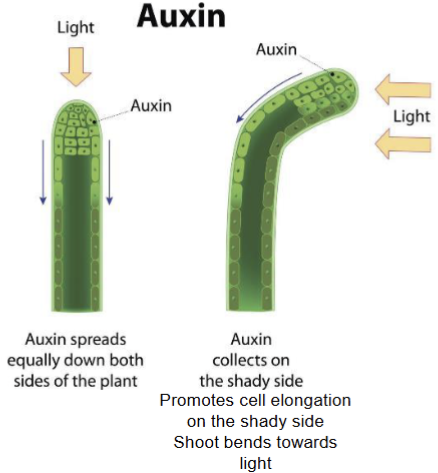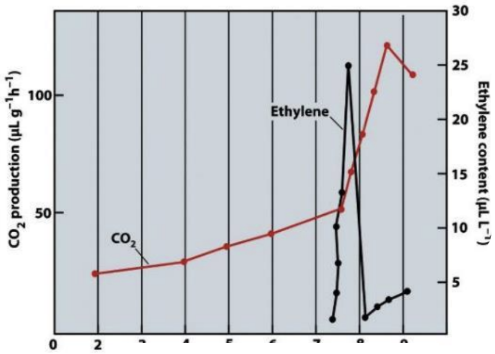Class 12
1/136
There's no tags or description
Looks like no tags are added yet.
Name | Mastery | Learn | Test | Matching | Spaced |
|---|
No study sessions yet.
137 Terms
Most plant responses to stimuli occur through:
Growth.
What are internal factors that affect plant growth?
Chemical factors and genetic.
What are external factors that affect plant growth?
Light, temperature, day length, gravity, touch, moisture, nutrient availability.
What is growth?
Oriented cell division and oriented expansion.
What is differentiation?
Formation of specific cell types.
What is morphogenesis?
Generation of form (shape).
What do cells need for normal plant development?
Information about position and developmental stage, cell-cell communication, and the ability to respond to the environment.
How does the formation of tissues and organs happen?
Through oriented cell division (anticlinal/periclinal) and expansion (later/radial and longitudinal).
How are cell division and expansion regulated?
Gene expression.
What is one way gene expression is regulated?
Gene expression.
What are hormones?
Chemical signals that regulate development and metabolism.
What are three characteristics of animal hormones?
They are synthesized in one place (specialized glands), are transported to cells in another part in the body where they produce a chemical response that alters gene expression to influence a physiological or developmental process.
What are similarities between plant and animal hormones?
They produce developmental and physiological responses, are active in very small quantities, act at the cellular level to turn gene expression on or off, and some plant hormones are produced in one tissue and transported to another.
What are differences between plant and animal hormones?
Some act only in the tissue where they are produced and plant hormones are not produced or stored in specialized tissue (glands).
What are plant hormones also called?
Growth regulators.
How do plants hormones work together?
Some plant hormones activate the synthesis of other hormones, some hormones oppose the activity of another hormone, but most often, a combination of specific hormones produces a response.
What are the steps for a plants (or animals) repsone to a stimulus?
Perception, transduction, and response.
What is perception?
Sensing the stimulus.
What is transduction?
Changing the stimulus to a form that can be communicated to other cells and parts of the plant, a hormone or other signaling molecule moves through vasculature or from cell to cell.
What is repsonse?
Change in growth, morphology, or physiology resulting from change in gene expression.
Where are cells transmitted?
Across cells, tissues, and organs.
How is stimulus detected at the cellular level?
A receptor molecule in the cell membrane (perception/reception).
Transduction at the cellular level:
The receptor transfers the signal to a secondary messenger within the cell.
Response/induction at the cellular level:
Secondary messengers direct a change in gene expression that will then produce a change in cell function.
What are the major plant hormones?
Auxin, Cytokinin, Ethylene, Abscisic acid, and Gibberellins.
What does auxin (IAA) do?
Apical dominance, adventitious rooting, and tropic responses.
What does cytokinin do?
Cell division, shoot production in tissue culture, and delay of leaf senescence.
What does gibberellin (GA) do?
Stem elongation, release from seed dormancy, and stimulation of flowering.
What does abscisic acid (ABA) do?
Stomatal closure, stress resistance, and induction of dormancy of seeds and buds in certain species.
What does ethylene (gas) do?
Abscission (leaves and fruits) and fruit ripening.
What is phototropism?
The growth of shoots toward light, demonstrated by Darwin.
What did Darwin propose?
That an “influence” is produced in the shoot tip and transmitted down the stem.

What was Darwin’s “influence” discovered to be?
Auxin, the first identified plant hormone.
What is auxin responsible for?
Differential cell elongation that produces tropisms (phototropism, gravitropism).
Where is auxin synthesized?
Primarily in leaf primordia, young leaves, developing seeds and roots.
What does auxin function in?
Tropisms, apical dominance, vascular tissue differentiation, inhibition of leaf and fruit abscission, phyllotaxis (leaf arrangement), lateral root development, and many developmental processes in roots and shoots.
What does auxin promote?
Fleshy fruit development.
How is auxin transported?
Polarly and nonpolarly.
Polar transport is nearly always:
Basipetal (away from the shoot tip downward in the stem and away from the root tip, upward in the root).
How does electrically neutral IAAH in acidic cell wall (pH 5) enter the cell?
By passive diffusion.
Where does IAA- exit the cell?
At the basal end, transported actively via efflux carriers (PIN proteins).
Where is cytokinin synthesized?
In tissues where cells are actively dividing, like root tips, organ primordia, and seeds.
What are the functions of cytokinin?
Delays leaf senescence, typically are transported in xylem (root to shoot), promote cell division, and shoot formation in tissue culture.
Cytokinin functions oppose:
Auxin (maintaining RAM).
What do auxin and cytokinin work together to promote?
Plant growth in tissue culture.
When does a callus form?
When a piece of plant tissue is placed on culture media, a mass of undifferentiated cells forms.
What can callus cells form?
Roots and/or shoots, new plants are clones of the original.
What do auxins promote?
Cell elongation and root formation in tissue culture, as well as root formation in callus.
What do cytokinin’s promote?
Cell division and shoot formation in tissue culture, as well as shoot formation in callus.
What does the ratio of auxin:cytoninin determine?
Root vs shoot formation in tissue culture and the fate of the callus.
High auxin/cytokinin:
Root formation.
High cytokinin/auxin:
Shoot formation.
Balanced auxin/cytokinin:
Undifferentiated cell (callus) proliferation.
When was ethylene discovered?
Around 1900, gas-burning street lamps caused trees to drop their leaves (abscission).
What does ethylene influence?
Promotes growth of most tissues, inhibits cell elongation, promotes fruit maturation, senescence, and abscission, can inhibit OR promote cell division, and synthesized in response to stress or damage (may provide signals to surrounding plants).
What does ethylene inhibit?
Vertical cell elongation.
What shows the “triple response” to ethylene?
Seedlings grown in the dark.
What does ethylene cause in the “triple response” plants?
Decreased vertical growth (shorter), increased lateral growth (wider), and horizontal growth (curve).
What helps protect shoots as they push through the soil to get to light after germination?
Being shorter, thicker, and curved.
What does ethylene promote?
The ripening of some fruits.
Which fruits ripen rapidly?
Climacteric fruits (banana, tomato, and avocado), they continue ripening after harvest.

What proceeds ripening and induces the increase in respiration?
A spike in ethylene production.
How is ethylene important for agriculture and economics?
Climacteric fruits are picked green and treated with ethylene before going to the market.
What can the ethylene climacteric fruits produce do?
Enhance ripening or overripen other climacteric fruits.
What can reduced ethylene production or sensitivity facilitate?
Food storage and transport.
What can inhibiting ethylene synthesis prolong?
The storage life of fruits and vegetables.
What is “dormin”?
A growth inhibitor found in dormant buds.
What is “abscisin”?
An accelerator of leaf and fruit abscission.
What is abscisic acid (ABA) involved in?
Preventing seed germination, root-to-shoot signaling, and response to drought stress, especially stomatal closure (no direct role in abscission).
Where is abscisic acid (ABA) synthesized?
Mature leaf roots.
What two things are correlated with ABA levels?
Seed quiescence and dormancy.
What is required to maintain dormancy/quiescence?
ABA.
What do seeds of mutants that are insensitive to ABA do?
Germinate within the fruit.
What is the breaking of dormancy correlated with?
Decreasing ABA levels.
What does ABA induce?
Rapid closure of stomata.
What is stomata closure due to?
Loss of turgor pressure in guard cells.
What is turgor pressure mediated by?
The vacuole.
Who identified gibberellins?
A researcher studying a fungal parasite of plants.
What does gibberellin (GA) do?
Induces seed germination (opposing ABA), promotes stem elongation, stimulates cell division and cell elongation, and can stimulate flowering (there are more than 136 naturally occurring gibberellin).
Where is gibberellin produced?
Seeds and young tissues, it is found throughout the plant body.
What are gibberellins important for?
Seed germination.
What do gibberellins do to dormancy?
They break dormancy and promote seed germination.
What do gibberellins do during germination?
They stimulate cell elongation, causing the radical (root) to emerge from the seed coat.
What do gibberellins stimulate?
The breakdown of the endosperm so the nutrients can be absorbed by the germinating seed.
What commercial used does gibberellin have?
Agricultural and commercial.
What happens to mutants that can’t perceive GA?
They are dwarfed.
What do hormones serve to do?
Coordinate cellular activities during growth and development.
Hormones control gene expression to:
Regulate oriented cell division and oriented cell expansion, and influence cellular processes.
How do we describe plant responses to external stimuli?
Prefix: environmental stimulus and root/suffix: plant response.
What is positive phototropism?
Grow towards light (shoots).
What is negative phototropism?
Grow away from light (roots).
Root/suffix - Tropic (tropism):
Response to stimulus by growing towards or away from the stimulus.
Root/suffix - Nastic (nasty):
Response to stimulus, but not specifically towards or away from the stimulus.
Root/suffix - Morphogenic (morphogenesis):
Response to stimulus by changing the growth pattern.
Prefix - Photo:
Light, daylength.
Prefix - Gravi:
Gravity, weight.
Prefix - Thigmo:
Touch (harmful or helpful).
Prefix - Thermo:
Temperature (cold or hot).
Prefix - Chemo:
Chemicals.
Prefix - Hydro:
Water (presence or absence).